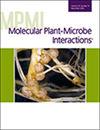Mst Shamira Sultana, Daniel Niyikiza, Tracy E Hawk, Nicole Coffey, Valéria Lopes-Caitar, Alexander C Pfotenhauer, Hana El-Messidi, Chris Wyman, Vince Pantalone, Tarek Hewezi
求助PDF
{"title":"Differential Transcriptome Reprogramming Induced by the Soybean Cyst Nematode Type 0 and Type 1.2.5.7 During Resistant and Susceptible Interactions.","authors":"Mst Shamira Sultana, Daniel Niyikiza, Tracy E Hawk, Nicole Coffey, Valéria Lopes-Caitar, Alexander C Pfotenhauer, Hana El-Messidi, Chris Wyman, Vince Pantalone, Tarek Hewezi","doi":"10.1094/MPMI-08-24-0092-R","DOIUrl":null,"url":null,"abstract":"<p><p>Soybean cyst nematode (SCN, <i>Heterodera glycines</i> [Hg]) is a serious root parasite of soybean (<i>Glycine max</i>) that induces extensive gene expression changes associated with pleiotropic biological activities in infected cells. However, the impacts of various SCN Hg types on host transcriptome reprogramming remain largely unknown. Here, we developed and used two recombinant inbred lines (RIL; RIL-72 and RIL-137) to profile transcriptome reprogramming in the infection sites during the resistant and susceptible interactions with SCN Hg Type 1.2.5.7 and Type 0. SCN bioassays indicated that RIL-72 was susceptible to Type 1.2.5.7 but resistant to Type 0, whereas RIL-137 was resistant to both types. Comparative analysis of gene expression changes induced by Type 1.2.5.7 in the resistant and susceptible lines revealed distinct transcriptome regulation with a number of similarly and oppositely regulated genes. The expression levels of similarly regulated genes in the susceptible line appeared to be insufficient to mount an effective defense against SCN. The functional importance of oppositely regulated genes was confirmed using virus-induced gene silencing (VIGS) and overexpression approaches. Further transcriptome comparisons revealed shared as well as Hg type- and genotype-specific transcriptome reprogramming. Shared transcriptome responses were mediated through common SCN-responsive genes and conserved immune signaling, whereas genotype-specific responses were derived from genetic variability, metabolic and hormonal differences, and varied regulation of protein phosphorylation and ubiquitination. The conserved defense mechanisms together with genotype-specific responses would enable plants to trigger effective and tailored immune responses to various Hg types and adapt the defense response to their genetic backgrounds. [Formula: see text] Copyright © 2024 The Author(s). This is an open access article distributed under the CC BY-NC-ND 4.0 International license.</p>","PeriodicalId":19009,"journal":{"name":"Molecular Plant-microbe Interactions","volume":" ","pages":"828-840"},"PeriodicalIF":3.4000,"publicationDate":"2024-12-01","publicationTypes":"Journal Article","fieldsOfStudy":null,"isOpenAccess":false,"openAccessPdf":"","citationCount":"0","resultStr":null,"platform":"Semanticscholar","paperid":null,"PeriodicalName":"Molecular Plant-microbe Interactions","FirstCategoryId":"99","ListUrlMain":"https://doi.org/10.1094/MPMI-08-24-0092-R","RegionNum":3,"RegionCategory":"生物学","ArticlePicture":[],"TitleCN":null,"AbstractTextCN":null,"PMCID":null,"EPubDate":"2024/12/17 0:00:00","PubModel":"Epub","JCR":"Q2","JCRName":"BIOCHEMISTRY & MOLECULAR BIOLOGY","Score":null,"Total":0}
引用次数: 0
引用
批量引用
Abstract
Soybean cyst nematode (SCN, Heterodera glycines [Hg]) is a serious root parasite of soybean (Glycine max ) that induces extensive gene expression changes associated with pleiotropic biological activities in infected cells. However, the impacts of various SCN Hg types on host transcriptome reprogramming remain largely unknown. Here, we developed and used two recombinant inbred lines (RIL; RIL-72 and RIL-137) to profile transcriptome reprogramming in the infection sites during the resistant and susceptible interactions with SCN Hg Type 1.2.5.7 and Type 0. SCN bioassays indicated that RIL-72 was susceptible to Type 1.2.5.7 but resistant to Type 0, whereas RIL-137 was resistant to both types. Comparative analysis of gene expression changes induced by Type 1.2.5.7 in the resistant and susceptible lines revealed distinct transcriptome regulation with a number of similarly and oppositely regulated genes. The expression levels of similarly regulated genes in the susceptible line appeared to be insufficient to mount an effective defense against SCN. The functional importance of oppositely regulated genes was confirmed using virus-induced gene silencing (VIGS) and overexpression approaches. Further transcriptome comparisons revealed shared as well as Hg type- and genotype-specific transcriptome reprogramming. Shared transcriptome responses were mediated through common SCN-responsive genes and conserved immune signaling, whereas genotype-specific responses were derived from genetic variability, metabolic and hormonal differences, and varied regulation of protein phosphorylation and ubiquitination. The conserved defense mechanisms together with genotype-specific responses would enable plants to trigger effective and tailored immune responses to various Hg types and adapt the defense response to their genetic backgrounds. [Formula: see text] Copyright © 2024 The Author(s). This is an open access article distributed under the CC BY-NC-ND 4.0 International license.
大豆胞囊线虫 0 型和 1.2.5.7 型在抗性和易感性相互作用过程中诱导的转录组重编差异。
大豆胞囊线虫(SCN,Heterodera glycines)是大豆(Glycine max)的一种严重根部寄生虫,可诱导感染细胞中与多生物活性相关的广泛基因表达变化。然而,各种 SCN Hg 类型对宿主转录组重构的影响在很大程度上仍然未知。在此,我们开发并使用了两个重组近交系(RIL-72 和 RIL-137),以分析在与 1.2.5.7 型和 0 型 SCN Hg 的抗性和易感性相互作用过程中感染部位的转录组重构情况。SCN 生物测定表明,RIL-72 对 1.2.5.7 型易感,但对 0 型有抗性,而 RIL-137 对两种类型都有抗性。通过比较分析 1.2.5.7 型在抗性品系和易感品系中诱导的基因表达变化,发现转录组的调控方式各不相同,存在一些类似调控和相反调控的基因。在易感品系中,类似调控基因的表达水平似乎不足以有效抵御 SCN。利用病毒诱导基因沉默和过表达的方法证实了对立调控基因的功能重要性。进一步的转录组比较显示了共同的以及汞类型和基因型特异的转录组重构。共有的转录组反应是通过常见的 SCN 反应基因和保守的免疫信号转导介导的,而基因型特异性反应则来自遗传变异、代谢和激素差异以及对蛋白质磷酸化和泛素化的不同调控。保守的防御机制和基因型特异性反应可使植物对不同类型的汞产生有效的、量身定制的免疫反应,并使防御反应适应其遗传背景。
本文章由计算机程序翻译,如有差异,请以英文原文为准。

 求助内容:
求助内容: 应助结果提醒方式:
应助结果提醒方式:


